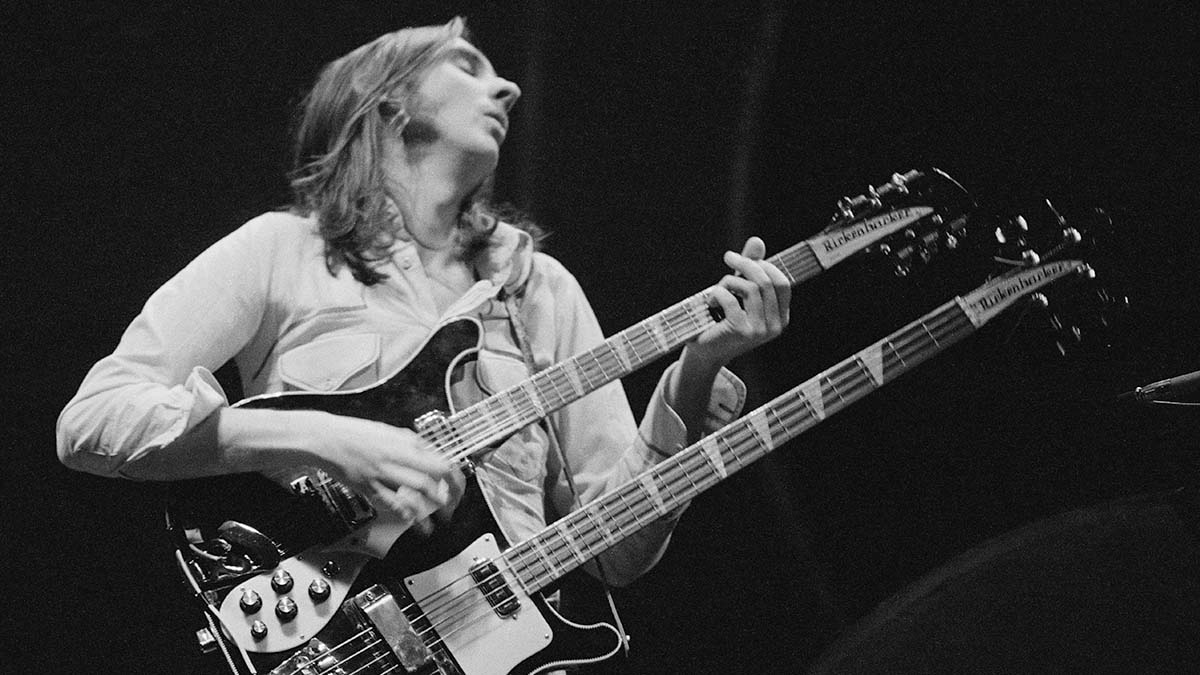Mike Rutherford: ”I covered a lot of ground with the double-neck and bass pedals – they gave the band an extra sound”
The Genesis and Mike + The Mechanics icon on pulling double shifts on a single instrument and finding inspiration on the pedalboard

Not long before a virus took over the planet, the big buzz in music for fans of progressive rock was the announcement that the legendary bassist Mike Rutherford would be rejoining Tony Banks (keyboards) and Phil Collins (vocals) in a reformation of their old band, Genesis.
For those of us of a certain vintage, it came as no surprise that the tour, now postponed for obvious reasons, sold out in double-quick time, forcing the trio to add further dates.
For those too young to recall, Genesis were one of the world’s premier live touring shows through the '70s, '80s, and early '90s. Back then, they could sell out a US stadium tour in less time than it takes to make a cup of tea, such was their pulling power.
Since 1985, Rutherford has also been the captain at the helm of Mike & The Mechanics, a constantly evolving band that has produced a significant back catalog of its own. We caught up with Mike a while back to discuss his early influences...
“I always tried to be melodic,” he explains, “but if you hear those early tracks now, you can tell I’m doing too much, with too many notes. We were all trying to find our niche at that time, but the older you get, the more you learn to play what is right for the song. It’s a process of learning when it’s applicable and when it’s not.
“I was looking to the greats at the time such as Jack Bruce, who had a unique sound and was a very melodic player. The McCartneys of this world are still great, because they’re musical bass players, and you have players like Pino Palladino, who has to be one of the most amazing players of all time – a lovely guy, and the fastest learner I’ve ever known.
“Play him a song twice and it’s there. I’m working my way around a part, and he already has it down.” The prog-rock scene of the early '70s was a fertile ground for ideas and sounds.
Get The Pick Newsletter
All the latest guitar news, interviews, lessons, reviews, deals and more, direct to your inbox!
Did Rutherford keep an eye on what his competitors were doing? “I never really knew much about Rush, for example,” he says. “I really don’t know much of their material, and I should investigate some of it sometime. I was very aware of Yes, though: I always thought Chris Squire was an amazing bass player.
“I went to see them years ago and I came away thinking how different they were to us, in a nice way. They were all virtuoso players, whereas we were more songwriters, and that was okay.”
Pedals are a huge part of how I write. I can be sitting in my studio at home writing with the bass pedals in front of me and playing guitar with a MIDI pickup to create a string sound to accompany myself
He adds: “Pedals are a huge part of how I write. I can be sitting in my studio at home writing with the bass pedals in front of me and playing guitar with a MIDI pickup to create a string sound to accompany myself. The bass pedals make you play unusual notes, once the chords are down.
“You play some weird notes which you might not do otherwise, so they’re a huge part of what I do and how I write.” Such were the scale of Genesis’s global jaunts that Rutherford was often sent prototypes for use on the road and in the studio.
As a result, the band were early adopters of new technology such as Trace Elliot amplification, Status instruments and Steinberger guitars and basses.
“At the time,” he recalls, “I thought of Trace Elliot as ‘the 4x10 sound’. It was a great way of focusing the sound and pumping a bit more, and for a long time, I loved using their gear. It tailed off in the '90s as the company and the gear changed, but when it first appeared, it was great – a real step up. In the days when I used a double neck, the treble pickup would run through a column of speakers, and the bass pickup would go through its own cabinets.”

Rumour has it that Rutherford was also responsible for creating the larger-bodied Steinberger bass body – any truth to that?
“Basically, I did [Genesis’s 1986 album] Invisible Touch and the corresponding tour with Steinberger guitars. I kept saying ‘It’s so small, can I have a bigger one?’ I asked them to build a bass with more of a body on it, but nothing happened, so I got some cardboard and drew out a shape and I got [luthier] Roger Giffen to build me one, which sounded pretty good.
“Steinberger then fiddled around with it and asked if they could copy it. They called it the M1, and that was how it happened, although of course, I didn’t get any design royalties! It was never quite as good, as it had a solid wooden body, whereas the basic original guitar was just a well-designed piece of graphite.
I often record bass through a guitar amplifier, because bass amps can sometimes pump too much into the sound
“The original bass was the same, and I loved that; the sound was so small and precise, but on the albums, it sounded huge and had a real character to it. You can hear it on [1983 album] Genesis and Invisible Touch, but it sounded good because it is what it is, a graphite body and neck – there’s nothing to it.
“Later, someone built me a shaped-body version with a gap in the middle for me to insert the original Steinberger, but I needed to find a way to attach it, so that all the resonance came from the graphite body part. Both the original guitar and bass sounded so good because they were, to a certain extent, quite crude.”

Needless to say, the Rutherford vaults house a fair few gems, amassed over the decades.
“I don’t tend to look at new instruments these days: for years, all my instruments were in cases in a barn, so they never came out, really. I now have a long wall at home where they all hang up so I can go and pick one when the whim takes me.
“We did a session a while back and we were flying straight out afterwards, so we rented gear in instead of taking our equipment. They provided a relic'd Mexican Fender Jazz, and I played it through a guitar amp: It sounded great, very light, too. I loved it. I often record bass through a guitar amplifier, because bass amps can sometimes pump too much into the sound.”
I’ve always been half and half in terms of being a guitarist and a bassist. Even when Steve Hackett was the lead guitarist in Genesis
He continues: “For the last eight years, I’ve used Ampeg on stage, and no matter where we are, those amps tend to sound the same, so I’ve got some consistency. I used to have an Alembic Series II, which I used for one tour, but I don’t know where it’s gone... it just disappeared. This tends to happen over the years. I had a white Gibson SG and that disappeared as well.”
The Mechanics require a similar setup to Genesis when it comes to the bass-playing department – a multi-faceted bassist/guitarist who can perform both roles.
“I still play bass on several songs, but we share it,” he explains. “I’m looking for a guitarist who can play rhythm, lead, and bass. It’s a bit like years ago when we got Daryl Stuermer in for the Genesis tours. The guy before Daryl joined was Alphonso Johnson, albeit briefly, and it took Daryl seven or eight years to really ‘get’ the bass. I think he always understood how to play the right part for the song.
“I’ve always been half and half in terms of being a guitarist and a bassist. Even when Steve Hackett was the lead guitarist in Genesis, sometimes I was playing guitar and covering the bass part on pedals, certainly the rhythmic parts.
“The thing about bass is that it’s quite difficult to play on its own as a solo instrument, but it comes to life when you play live and on record as part of a band. I always put the drum machine part down first, followed by some guitar parts – but when the bass part comes in, if you get it right, it can give the song a huge lift.”
Many of those Genesis basslines are revered to this day. Was he aware that his band were creating future classics?
“No, you never are – when you’re doing it, you don’t think about how it will be thought of in years to come. In a sense, I covered a lot of ground with the double-neck instrument and the bass pedals – they gave the band an extra sound. Mind you, we were at soundcheck the other day, and totally out of the blue, I played the bassline to The Lamb Lies Down On Broadway. It has a bit of character to it, and I thought to myself, ‘That’s actually quite good’...”
“There’d been three-minute solos, which were just ridiculous – and knackering to play live!” Stoner-doom merchants Sergeant Thunderhoof may have toned down the self-indulgence, but their 10-minute epics still get medieval on your eardrums
“There’s a slight latency in there. You can’t be super-accurate”: Yngwie Malmsteen names the guitar picks that don’t work for shred

![A black-and-white action shot of Sergeant Thunderhoof perform live: [from left] Mark Sayer, Dan Flitcroft, Jim Camp and Josh Gallop](https://cdn.mos.cms.futurecdn.net/am3UhJbsxAE239XRRZ8zC8.jpg)








